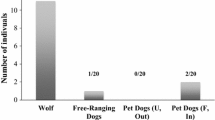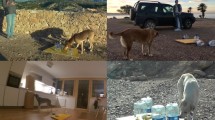Abstract
Life experiences and living conditions can influence the problem-solving strategies and the communicative abilities of dogs with humans. The goals of this study were to determine any behavioural differences between Labrador Retrievers living in a kennel and those living in a house as pets and to assess whether kennel dogs show preferences in social behaviours for their caretaker relative to a stranger when they are faced with an unsolvable task. Nine Labrador Retrievers living in a kennel from birth and ten Labrador Retrievers living in a family as pets were tested. The experimental procedure consisted of three “solvable” tasks in which the dogs could easily retrieve food from a container followed by an “unsolvable” task in which the container was hermetically locked. Dogs of both groups spent the same amount of time interacting with the experimental apparatus. Kennel dogs gazed towards people for less time and with higher latency than pet dogs; however, there were no significant preferences in gazing towards the stranger versus the caretaker in both groups. These findings demonstrated that kennel dogs are less prone to use human-directed gazing behaviour when they are faced with an unsolvable problem, taking the humans into account to solve a task less than do the pet dogs.


Similar content being viewed by others
References
Agnetta B, Hare B, Tomasello M (2000) Cues to food location that domestic dogs (Canis familiaris) of different ages do and do not use. Anim Cogn 3:107–112
Barrera G, Mustaca AE, Bentosela M (2011) Gaze at the human face in shelter and pet dogs. Anim Cogn 14:727–734
Barrera G, Giamal Y, Mustaca A, Bentosela M (2012) Relación entre el tipo de alojamiento y las respuestas de mirada, sociabilidad y miedo-apaciguamiento en perros (association between type of housing, gaze, sociability and fear appeasement behaviors). Sum Psicol 19:7–18
Barrera G, Fagnani J, Carballo F, Giamal Y, Bentosela M (2015) Effects of learning on social and nonsocial behaviors during a problem-solving task in shelter and pet dogs. J Vet Behav 10(4):307–314
Cooper JJ, Ashton C, Bishop S, West R, Mills DS, Young RJ (2003) Clever hounds: social cognition in the domestic dog (Canis familiaris). Appl Anim Behav Sci 81:229–244
D’Aniello B, Scandurra A, Prato-Previde E, Valsecchi P (2015) Gazing toward humans: a study on water rescue dogs using the impossible task paradigm. Behav Process 110:68–73
Gaunet F (2008) How do guide dogs of blind owners and pet dogs of sighted owners (Canis familiaris) ask their owners for food? Anim Cogn 11:475–483
Hare B (2004) Domestic dog use humans as tools. In: Bekoff M (ed) Encyclopedia of animal behavior, vol 1. Greenwood Press, Westport, pp 277–285
Hare B, Tomasello M (2005) Human-like social skills in dogs? Trends Cogn Sci 9:439–444
Hare B, Brown M, Williamson C, Tomasello M (2002) The domestication of social cognition in dogs. Science 298:1634–1636
Hare B, Plyusnina I, Ignacio N, Schepina O, Stepika A, Wrangham R, Trut L (2005) Social cognitive evolution in captive foxes is a correlated by-product of experimental domestication. Curr Biol 16:226–230
Hare B, Rosati A, Kaminski J, Bräuer J, Call J, Tomasello M (2010) The domestication hypothesis for dogs’ skills with human communication: a response to Udell et al. (2008) and Wynne et al. (2008). Anim Behav 79:e1–e6
Hori Y, Kishi H, Inoue-Murayama M, Fujita K (2013) Dopamine receptor D4 gene (DRD4) is associated with gazing toward humans in domestic dogs (Canis familiaris). Open J Anim Sci 3(1):54–58
Jakovcevic A, Mustaca A, Bentosela M (2012) Do more sociable dogs gaze longer to the human face than less sociable ones? Behav Process 90:217–222
Marshall-Pescini S, Passalacqua C, Barnard S, Valsecchi P, Prato-Previde E (2009) Agility and search and rescue training differently affects pet dogs’ behaviour in socio-cognitive task. Behav Process 78:449–454
Miklósi Á, Kubinyi E, Topál J, Gácsi M, Virányi Z, Csányi V (2003) A simple reason for a big difference: wolves do not look back at humans, but dogs do. Curr Biol 13:763–766
Miklósi Á, Pongrácz P, Lakatos G, Topál J, Csányi V (2005) A comparative study of the use of visual communicative signals in interactions between dogs (Canis familiaris) and humans and cats (Felis catus) and humans. J Comp Psychol 119:179–186
Naderi S, Miklósi Á, Dóka A, Csányi V (2001) Co-operative interactions between blind persons and their dogs. Appl Anim Behav Sci 74:59–80
Passalacqua C, Marshall-Pescini S, Barnard S, Lakatos G, Valsecchi P, Prato-Previde E (2011) Breed and age group differences in human-directed gazing behaviour. Anim Behav 82:1043–1050
Persson ME, Roth LSV, Johnsson M, Wright D, Jensen P (2015) Human-directed social behaviour in dogs shows significant heritability. Genes Brain Behav 14(4):337–344
Savolainen P, Leitner T, Wilton AN, Matisoo-Smith E, Lundeberg J (2004) A detailed picture of the origin of the Australian dingo, obtained from the study of mitochondrial DNA. PNAS 101(33):12387–12390
Scandurra A, Prato-Previde E, Valsecchi P, D’Aniello B (2015) Guide dogs as model for investigating the effect of life experience and training on gazing behaviour. Anim Cogn 18:937–944
Smith BP, Litchfield CA (2013) Looking back at ‘looking back’: operationalising referential gaze for dingoes in an unsolvable task. Anim Cogn 16:961–971
Svartberg K (2006) Breed-typical behaviour in dogs—historical remnants or recent constructs? Appl Anim Behav Sci 96:293–313
Thalmann O, Shapiro B, Cui P, Schuenemann VJ, Sawyer SK, Greenfield DL, Germonpré MB, Sablin MV, López-Giráldez F, Domingo-Roura X, Napierala H, Uerpmann HP, Loponte DM, Acosta AA, Giemsch L, Schmitz RW, Worthington B, Buikstra JE, Druzhkova A, Graphodatsky AS, Ovodov ND, Wahlberg N, Freedman AH, Schweizer RM, Koepfli KP, Leonard JA, Meyer M, Krause J, Pääbo S, Green RE, Wayne RK (2013) Complete mitochondrial genomes of ancient canids suggest a European origin of domestic dogs. Science 342:871–874
Topál J, Miklósi Á, Csányi V (1997) Dog–human relationship affects problem solving behaviour in the dogs. Anthrozoos 10:214–224
Udell MAR, Wynne CDL (2008) A review of domestic dog (Canis familiaris) human-like behaviors: or why behavior analysts should stop worrying and love their dogs. J Exp Anal Behav 89:247–261
Udell MAR, Wynne CDL (2010) Ontogeny and phylogeny: both are essential to human-sensitive behaviour in the genus Canis. Anim Behav 79:e9–e14
Udell MAR, Dorey NR, Wynne CDL (2008) Wolves outperform dogs in following human social cues. Anim Behav 76:1767–1773
Udell MAR, Dorey NR, Wynne CDL (2010) What did domestication do to dogs? A new account of dogs’ sensitivity to human actions. Biol Rev 85:327–345
Wynne CDL, Udell MAR, Lord KA (2008) Ontogeny’s impact on human–dog communication. Anim Behav 76(4):e1–e4
Acknowledgments
We thank the FOOF museum staff for their perfect logistical support and hospitality. This research has been supported by ordinary funding of University of Naples “Federico II”.
Author information
Authors and Affiliations
Corresponding author
Rights and permissions
About this article
Cite this article
D’Aniello, B., Scandurra, A. Ontogenetic effects on gazing behaviour: a case study of kennel dogs (Labrador Retrievers) in the impossible task paradigm. Anim Cogn 19, 565–570 (2016). https://doi.org/10.1007/s10071-016-0958-5
Received:
Revised:
Accepted:
Published:
Issue Date:
DOI: https://doi.org/10.1007/s10071-016-0958-5




